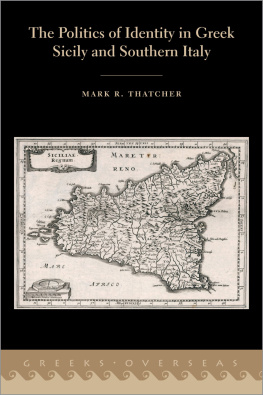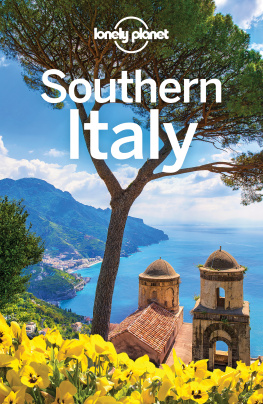
BETWEEN SALT WATER
AND
HOLY WATER
A History
of Southern Italy

TOMMASO ASTARITA

Some images in this e-book are not displayed owing to permissions issues.
Contents

I
WHERE THE ROMANS MET THE GREEKS
The Italian South in Antiquity
II
FROM THE TERROR OF THE WORLD TO THE WONDER OF THE WORLD
The Kings Who Created the Italian South
III
SICILY SPLITS AND NAPLES RISES
The South in the Late Middle Ages
IV
SUBJECT TO A DISTANT KING
The South in the Spanish Empire
V
THE INDIES OVER HERE
Church and Religion in the Early Modern South
VI
PARADISE INHABITED BY DEVILS
Culture and Society in Baroque Naples
VII
REASON TRULY IS ALWAYS BEAUTIFUL
The Southern Enlightenment
VIII
THE GRAND TOUR HEADS SOUTH
Nature, Ruins, Music, and Folklore
IX
FEAST, FLOUR, AND GALLOWS
Revolution, Restoration, and the End of a Kingdom
X
THE SOUTH AS PART OF THE ITALIAN NATION
Note: Some images in this e-book are not displayed owing to permissions issues.
Preface
&
Acknowledgments
I was born and raised in Naples and still spend a part of each year there. Like most Neapolitans I knowand not just those who have leftI have a conflicted relationship with my hometown. Many of us are the citys harshest critics, and yet all of us are fiercely defensive when outsiders speak ill of it, as they often do. Napless population density today is one of the highest in the Western world, and the city suffers from all the attendant difficulties of dirt, noise, chaos, and crime. Visitors tell us that Naples reminds them of Bombay or Cairo, and we want to remind them that we are Europeans and secretly wish someone would mistake Naples for Stockholm or Bern.
The image of Naples and more generally of the Italian South as at best the end of Europe is a very old one. This rhetoric was a staple of northern Italian patriotic writing in the nineteenth century. Northerners felt the duty to liberate their southern brethren from oppression and were confident that political unification would bring the South into modern Europe and eliminate southern ignorance, poverty, and superstition. In the eighteenth century the philosophers of the Neapolitan Enlightenment wrote that as soon as one exited the gates of Naples, one was among savages. Already in the sixteenth century, Jesuit priests spoke of the southern Italian countryside as the Indies over here.
This rhetoric is alive and well today, in both popular and scholarly texts. The 1980s English-language Michelin guide to Naples opened by describing Neapolitans as small, dark, friendly, and superstitious. A French historian recently argued that the study of southern Italy requires the same mental tools applied to the study of populations entirely alien to European and modern realities. Yet the identity of the Italian South, and its place in the Western imagination, has always been more nuanced than this common rhetoric indicates, and here is one root of the uneasiness we contemporary Neapolitans feel about our homeland.
Southern Italy was the cradle of early civilization in the western Mediterranean, and significant and beautiful ancient sites still dot the region. Medieval Palermo was one of Europes wealthiest and most splendid cities. The University of Naples is old and renowned, and the city was one of the largest and most important in Europe from the fifteenth through the nineteenth century. It is difficult to understand European music or art in the seventeenth and eighteenth centuries without considering those produced in Naples. An eighteenth-century gentlemans education was not complete without a prolonged stay in the Italian South, where nature and history taught him the essence of being a cultivated European. In the early twentieth century, Benedetto Crocepassionately attached to his home citywas one of Europes leading intellectuals, completing a list of great Neapolitan philosophers that begins with Thomas Aquinas.
It is this contradictionbetween the centrality of the Italian South to European life and culture on the one hand and the many elements of its distance from what Europeans have long regarded as modern (in economic, social, political, and spiritual terms) on the otherthat I believe makes natives and visitors ambivalent in their feelings about the region. In a sense Naples and the South have always been both deeply of Europe and at the same time outside of it.
In late spring of 2003, as I worked on this book and reflected on these themes, the contradictory images of Naples appeared in my daily papers. On May 17, in the Washington Post, reporter Daniel Williams wrote of a recent garbage collection strike that was filling Naples with chaos and bad smells. It was a classic, frustrating version of the bad side of the story: crime networks, corrupt or inefficient government, dirt, decay, and a big photo of piles of garbage. Less than a month later, in the travel section of the New York Times, the novelist Francine Prose wrote a long article about Naples: after the inevitable mention of the colorful street life and the great food, she focused on the beautiful art, architecture, and archeology found in the citys museums and churches. She left no doubt that she was describing a great European city. As I prepared to review the proofs for this book at the end of 2004, the cycle of good and bad images of the city continued: a spate of gang killings and a great exhibition of Caravaggios late works brought yet again the attention of the international media to Naples. My hope in the pages that follow is to shed some light on both images, and on the realities behind them.

I am grateful to the staff of the Sezione Napoletana of the Biblioteca Nazionale di Napoli, of the Biblioteca della Societ Napoletana di Storia Patria, of Georgetowns Lauinger Library (especially the Inter-Library Loan office), and of the Library of Congresss Rare Book Collection. The Graduate School at Georgetown helped defray the costs of illustrations. Michael Kazin and Aviel Roshwald first suggested that I write an overview of southern Italian history for a general audience. Many colleagues encouraged me and offered useful suggestions when I presented excerpts to our department. My chair, John Tutino, was enthusiastic about the project (and promised to buy a copy of the book). Alane Salierno Mason of W. W. Norton has accompanied the project since its start; though I am not sure that I ever learned to think like my editor, I hope she is not unhappy with the result of my and her efforts.
Several friends read various parts of the manuscript and gave me the benefit of their comments and corrections. For their help and friendship I am very grateful to Larry Cohen, Thomas Cole and Carol Hartley, Bertrand Forclaz, Gregor Kalas, Josiah Osgood, Silvana Patriarca, Ugo Piomelli, Jeffrey Richter, Gaetano Sabatini, Richard Stites, Wendy Thompson, and especially John McNeill. I began work on this project in the lovely setting of Georgetowns center in Fiesole, where I enjoyed the stimulating company of Marcello Fantoni, Kate Magovern, and the other colleagues and staff members. Bonita Billman, Gregor Kalas, and Thomas Willette helped me to find and choose illustrations. I am also grateful to Trevor Burnard and Deborah Morgan, Alessandra Galizzi, Alison Games, Amy Leonard, Luigina Mattioli, Marco Moracci and Maria Adele Scaramella, Patrick OMalley, Adam Rothman, Jordan Sand, Francesca Santovetti and David Gillerman, and Paul Young for their friendly support. My family in Naples and Rome were always interested and helpful.
Next page










